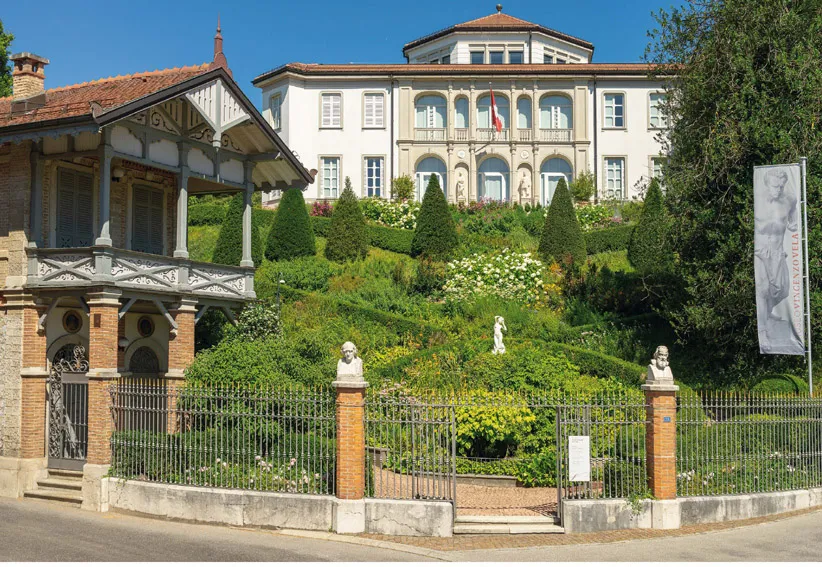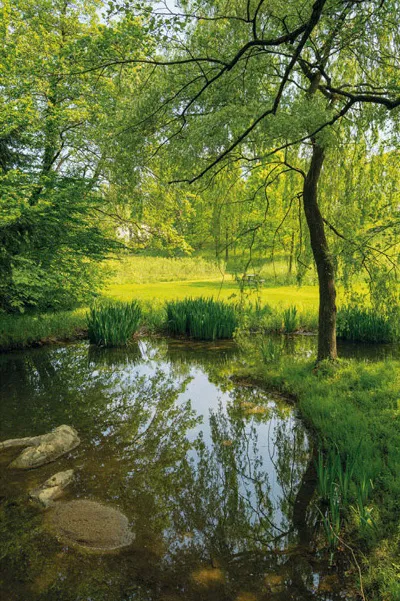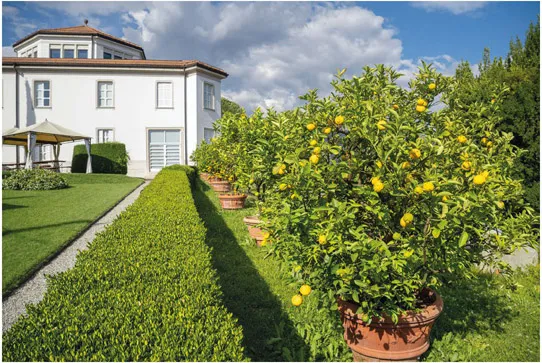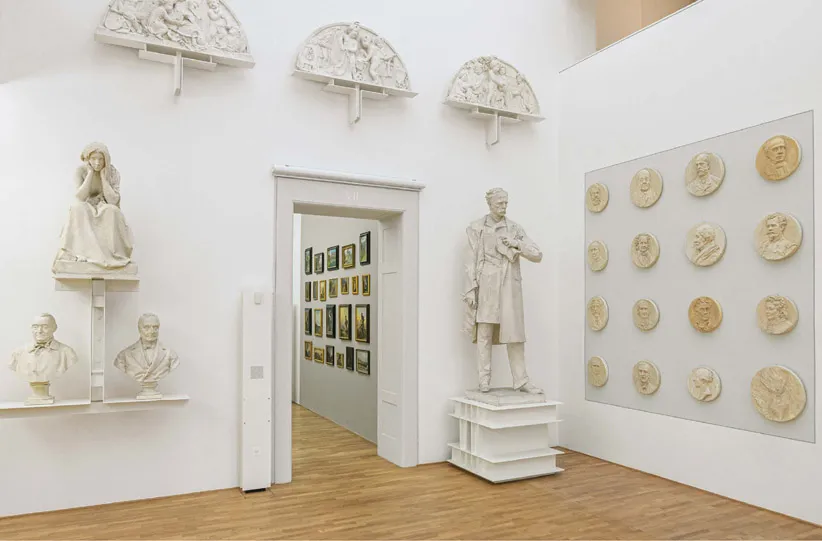![]()
A look at Museo Vincenzo Vela from the South with the caretaker’s lodge, 2019.
Museo Vincenzo Vela Today
A visit to the museum begins already in the historic centre of Ligornetto. The hill-top villa can be easily seen from the village in the plain, whose gargoyle fountains and a small public washhouse were created by Vela and donated to the town, his birthplace. A plaque from 1899 at the post bus stop cites the sculptor and his son Spartaco as town benefactors. Also noteworthy is the public scale at the crossroads, surmounted by a statue of Justice (1855), another gift from the artist. The allegorical figure wielding a scale and a sword creates a visual and narrative link between the town and the villa.
An architectural stroll
Today, the main entrance to the museum is located on the left side of the building, conveniently close to the rear parking lot, leading through the former carriage door. It is pleasant, however, to approach the complex from the village, following the scenic walkway conceived by Vela, to appreciate the impressive southern facade in all its glory. The pillars at the garden entrance are adorned with portrait busts of Galileo Galilei and Christopher Colombus (1865), considered ‘great men’ of history and trailblazers of a modern, enlightened vision of the world. A pond with a tufa grotto, featuring a replica of the marble statue Spring/Flora (1865), and the Swiss chalet-style caretaker’s lodge (1881) by Augusto Guidini lead on to the museum. As one climbs one of the two figure-eight paths up the slope, the view over the roofs of the town opens progressively onto a scenic ‘horizon of Italy’ (Guidini).
The unique building is one of the first art museums founded in Switzerland in the 19th century. In keeping with the architectural canons of the period, the representative classicist facade is intended as a prelude to the interior. Inspired by similar facades of art academies in the 19th century, the exterior iconography expresses Vela’s concept of a private art museum as a cultural institution for the people. The niches walled up in 1896, between glased arcades, hold statues of the poet Dante on the left and the painter Giotto on the right (1865), which are small-scale copies of the monuments in Padua (see p. 29). Above these founding fathers of Italian culture hang portrait medallions of Michelangelo and Raphael (c. 1865), who, according to common opinion, brought Renaissance sculpture and painting to perfection. Vela sought to fuse these two arts into a single new unit in his statues and reliefs, fulfilling himself as an artist while carrying on the tradition.
The historic garden
The stately country villa on the scenic hill is surrounded by vineyards, fields and chestnut woods. Just as relevant historically, however, is the park, an integral part of this total artwork, created at the time by an unknown landscape architect. The field to the south-west of the museum is open to the public and often used for outdoor displays of contemporary sculpture in temporary exhibits as well as for other cultural events.
The entire area is a fine example of a mid-19th century villa with garden, blending architectural and landscape elements in a harmonious whole. The current grounds, only half the size of the original garden but still partially enclosed by the old wall, are divided into several distinct landscape areas, as per the original plans. To create a suitably impressive entrance, the slope boasts an Italianate geometrical design with a boxwood border, laurel bushes and conic yew-trees, as well as features a grotto and criss-crossing access paths that join up elegantly.
Three views of the park nowadays.
The private area, with its greenhouse, fruit orchard and herb garden, is located to the left on the terraces of the old vineyard, while a field bordered by cypress and bands of lavander occupies the south-west side. A bit hidden to the back is an English-style garden, cultivated as a natural landscape with bushes, trees, grasses and a pool, with a shady backdrop provided by a stand of chestnut and oak trees. Complementary to the buildings, with its alternation between exotic and native plants, the vegetation gives the grounds much of their charm and generates a dynamic dialogue between art and sculpted nature. In summer, there are many citrus plants with fantastic, at times bizarrely shaped fruits, including species dating back to the Renaissance collection of the Medici of Florence.
The Roman numerals of the rooms do not correspond to a chronological itinerary (for the number system, see floorplan).
After years of neglect, since 1995, the entire complex has been protected in accordance with the ICOMOS-IFLA guidelines, and beginning in 2001, the original structure has been restored in various stages according to a design by Guido Hager, specialist in historic gardens. Thanks to the gradual cultivation of differentiated vegetation, the garden’s original arrangement into sections has become more apparent.
These efforts, promoted by Daniele Reinhart and the museum administration, have resulted in a group of camellias, a small woods to the north, the citrus collection in the greenhouse with one-of-a-kind plants and the partial restoration of the old pond, while since 2015 greater attention has been devoted to biodiversity. By eliminating invasive plants whose uncontrolled growth had overwhelmed the local vegetation, the landscape architect Heiner Rodel has created a harmonious balance. New elements have been successfully grafted onto older ones to ensure that the park continues to thrive well into the future.
Visit
After the architect Mario Botta’s well chosen restorations and reorganization of the museum (1998–2001), the director adapted the concept guiding the display of the collection to the new spatial arrangement and then revamped it again in 2015. The composition reflects Vincenzo Vela’s idea of a ‘viewing warehouse’, offering many varied ways to experience his works. The central octagonal room with the monumental plaster originals was re-established as the hub of the museum and other important works by the sculptor were grouped by theme in the surrounding rooms.
Preliminary and final models, along with other related pieces from the rich store of drawings, art prints, plaster casts and period photographs, help visitors reconstruct the creative process behind the various sculptures, from conception to completion. Also on display are decorative works by Vincenzo’s brother Lorenzo, paintings by his son Spartaco, and the finest paintings from the Vela family picture gallery. Thus, the permanent exhibition of the collection functions as a sort of historical laboratory suspended in time, a veritable time capsule. Visitors have the rare opportunity to understand and stand right beside the statues, to feel the interaction between space, artwork and function, and to imagine the original context of the artist’s house, thanks to the museum’s educational materials.
The itinerary begins in the atrium (VIII) with works by Spartaco Vela. From there, one reaches the lower floor with the cloakroom and the first floor with temporary exhibits. The Monument to Bishop Giuseppe Maria Luvini of Pesaro (1844–1845, see ill. p. 5), a figure sculpted for a niche in the new City Hall building in Lugano, was Vela’s first public commission and also the first with a political message. Taking the opportunity to display his mastery of detailed, painterly modelling of the figure, Vela soon managed to gain critical acclaim when the statue was exhibited at the Brera in Milan in autumn 1845. The sculpture also reveals Vela’s ability to, from the very beginning, create portraits informed by a profound psychological sensitivity. In this atypical case, the sculpture on display is not a plaster original but a cast of the finished sculpture, which Vincenzo’s son Spartaco had made in 1895 to complete the collection before the museum opened.
A look at the Room VII. Left: Desolation (1850) and The Portrait Bust of Giacomo Ciani and Filippo Ciani (1869), right: Monument to Agostino Bertani (1887), on the wall: portrait medallions from all stages of Vela’s career.
Room VII. Symbols of resurgence and new heroic figures
The room adjacent to the entrance was originally an open courtyard for horses and carriages. When the villa was reconfigured as a museum (1913–1919), it was transformed into a semi-circular porticoed room to house the statues, and then, with Mario Botta’s renovation, it was transformed again into a large two-storey open space. High up on two walls appear the original plaster models of six relief lunettes by Lorenzo Vela, illustrating allegories of the arts, trades and commerce. The lunettes were part of a decorative project (1869–1873) undertaken by Lorenzo for the new headquarters (called the ’Ca’ de’ Sass’) of the Cassa di Risparmio delle Provincie Lombarde in Milan, testifying to the pride of the new nation, whose northern cities powered the country’s economic boom.
The original plaster models highlight one of a 19th century sculptor’s most important types of commissions – monuments and portrait busts of distinguished men and women of the time. This room is devoted to symbols of the resurgence and new heroes of the burgeoning modern middle class, whose political views the artist shared. The group of works admirably illustrate how well the sculptor succeeded in understanding and interpreting liberal values. Like his clients in Milan and Turin, he pursued the goal of liberating Italy from foreign domination and unifying it as a single nation. Despite being a Swiss citizen, he created monuments in honour of outstanding Italians whose virtues made them worthy models for the population. Once enjoying pride of place, these silent protagonists of the Risorgimento stand virtually unnoticed today, slowly deteriorating under the relentless pollution.
Inspired by Michelangelo’s Slaves and Bernini’s David, Vela’s statue of Spartacus (1847–1849, see p. 6, ill. p. 8), ...





